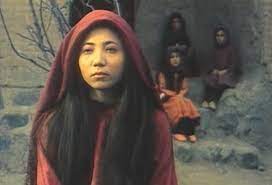Introduction:
“Shirin,” a 2008 Iranian documentary drama directed by Abbas Kiarostami, unfolds as a unique and contemplative exploration of human emotion and storytelling. Breaking away from traditional narrative structures, the film immerses viewers in a captivating cinematic experience that transcends the boundaries between documentary and drama. In this extensive review, we delve into the thematic depth, artistic brilliance, and cultural significance that define “Shirin.”
I. Abbas Kiarostami’s Cinematic Vision:
- Pioneering Filmmaker:
- Abbas Kiarostami, an iconic figure in Iranian cinema, is known for his innovative and thought-provoking approach to storytelling. “Shirin” exemplifies his penchant for pushing cinematic boundaries and challenging conventional norms.
- Minimalism and Poetic Realism:
- Kiarostami’s films are often characterized by minimalism and poetic realism. “Shirin” continues this tradition, presenting a visually and emotionally evocative tapestry that unfolds in the intersection of reality and fiction.
II. Plot Overview:
- An Unconventional Narrative:
- “Shirin” departs from traditional storytelling by focusing on the reactions of an audience watching a film. The film captures the faces of Iranian women as they watch a cinematic adaptation of the tragic love story of Khosrow and Shirin, a classic Persian tale.
- The Audience’s Gaze:
- The film’s narrative is shaped by the diverse reactions of the women in the audience. Through their expressions and emotions, the film becomes a study of the human gaze, allowing viewers to witness a myriad of responses to the unfolding drama on the screen.
III. Thematic Exploration:
- The Power of Storytelling:
- At its core, “Shirin” is a meditation on the power of storytelling. The film invites viewers to reflect on the ways in which narratives resonate with individuals, evoking emotions and connecting them to shared human experiences.
- Emotional Resonance:
- By capturing the emotional responses of the audience, the film delves into the universal themes of love, longing, and tragedy. The viewer becomes both an observer and a participant in the collective emotional journey.
IV. Artistic Brilliance:
- Innovative Cinematic Approach:
- “Shirin” stands out for its innovative cinematic approach. The film challenges traditional storytelling by placing the audience within the film itself, blurring the lines between the cinematic experience and the emotional reactions it elicits.
- Visual Composition:
- Kiarostami’s visual composition in “Shirin” is a masterclass in framing and capturing the human face as a canvas of emotion. The close-ups of the women’s faces become a window into their inner worlds, enhancing the film’s impact.
V. Cinematography and Aesthetic Choices:
- Evocative Imagery:
- The film employs evocative imagery, utilizing close-ups and facial expressions to convey the emotional undercurrents of the audience. The juxtaposition of these reactions with the epic love story on the screen adds layers of meaning to the narrative.
- Symbolic Elements:
- Symbolic elements, such as the juxtaposition of the audience and the film within the film, contribute to the film’s depth. Kiarostami’s use of visual metaphors invites viewers to engage in a contemplative dialogue on the nature of cinema and human connection.
VI. Performances:
- The Audience as Performers:
- The performances in “Shirin” are unique in that the primary actors are the women in the audience. Their genuine reactions and emotional responses become a form of collective performance that enriches the film’s authenticity.
- Empathy and Connection:
- Through the audience’s reactions, “Shirin” fosters a sense of empathy and connection. The film becomes a shared experience, inviting viewers to recognize the universality of emotion and the ways in which stories resonate across cultural boundaries.
VII. Critical Reception:
- International Acclaim:
- “Shirin” received international acclaim for its innovative approach and thematic depth. The film was celebrated for its ability to transcend cultural and linguistic barriers, offering a universal exploration of human emotion.
- Cannes Film Festival:
- Premiering at the Cannes Film Festival, “Shirin” garnered attention for its unconventional narrative and its impact on the audience. The film’s inclusion in prestigious festivals solidified its place in the global cinematic landscape.
VIII. Cultural Significance:
- Reflection of Iranian Culture:
- While “Shirin” explores universal themes, its roots are firmly embedded in Iranian culture. The choice of the Khosrow and Shirin narrative reflects Kiarostami’s commitment to preserving and celebrating Persian literary traditions.
- Conversation on Cinema:
- “Shirin” has sparked conversations within the cinematic community about the nature of storytelling and the role of the audience in shaping the cinematic experience. Its cultural significance extends beyond Iran, contributing to broader discussions on the art of cinema.
IX. Legacy and Continuing Impact:
- Influence on Filmmaking:
- “Shirin” has left an indelible mark on the landscape of world cinema, influencing filmmakers to explore unconventional narrative structures and engage with the audience as an integral part of the cinematic experience.
- Kiarostami’s Legacy:
- As one of Abbas Kiarostami’s final works before his passing, “Shirin” contributes to the filmmaker’s legacy as a visionary who challenged the norms of cinema and expanded the possibilities of storytelling.
X. Conclusion:
“Shirin” emerges as a cinematic gem that invites audiences to embark on a contemplative journey into the heart of human emotion. Abbas Kiarostami’s innovative approach, coupled with the genuine performances of the audience, creates a film that transcends the boundaries of traditional narrative. As the women in the audience watch the tragic love story unfold, viewers, too, become participants in the shared experience of storytelling. “Shirin” stands as a testament to the enduring power of cinema to evoke emotions, foster connection, and illuminate the intricacies of the human soul.








